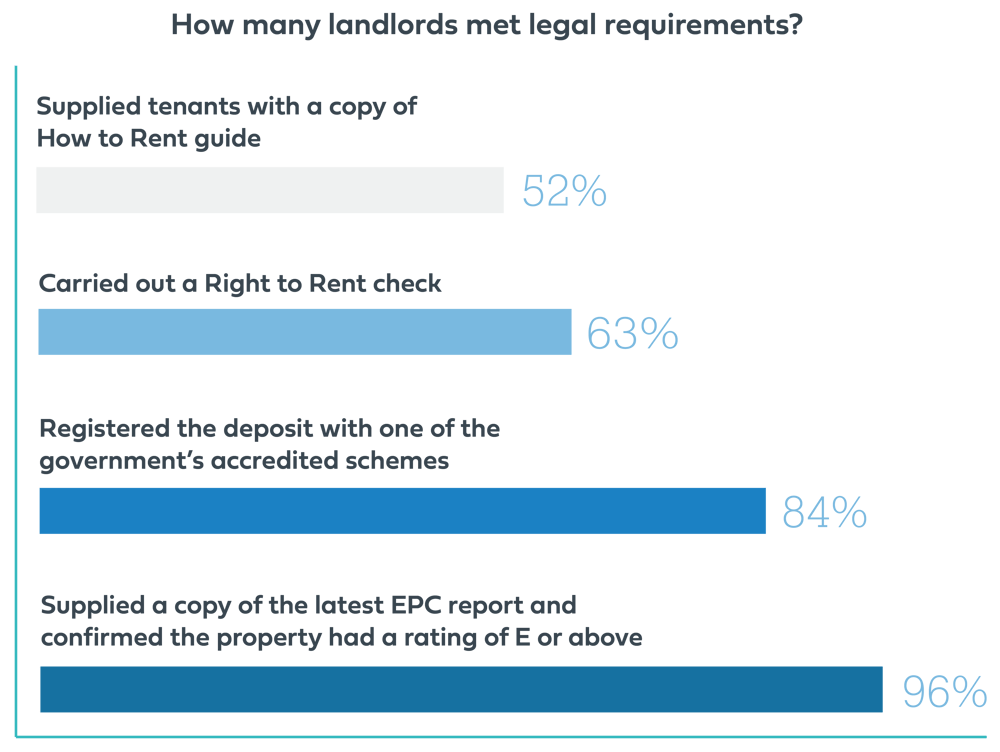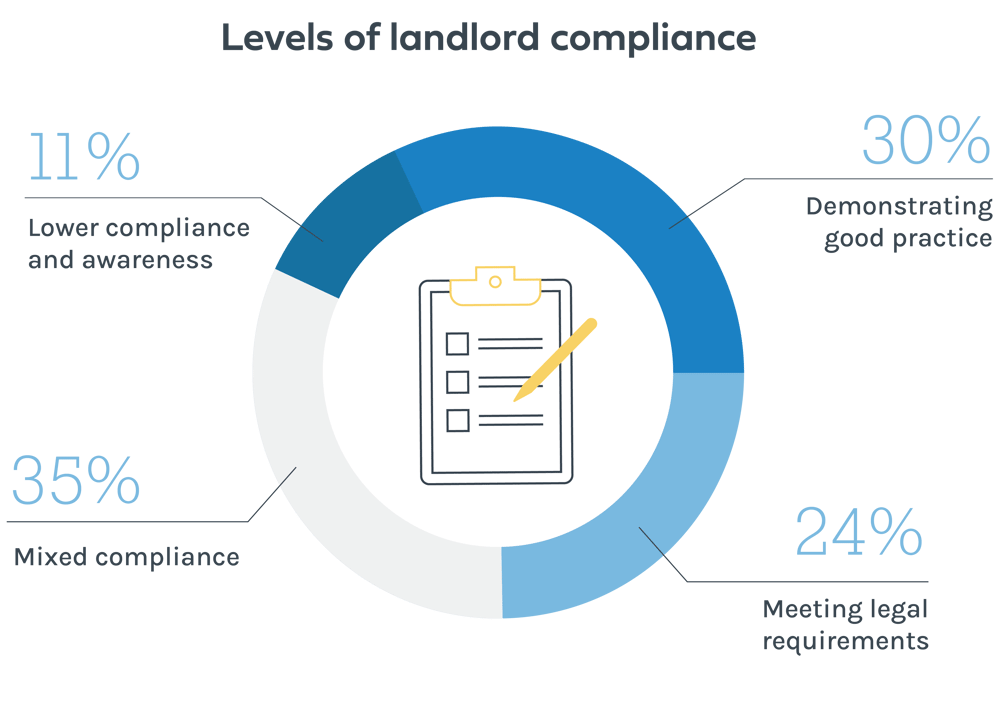Landlord compliance - Are landlords following legal and best practices?
Analysis of data from the Government’s English Private Landlords Survey 2022 has revealed some interesting results about landlord behaviour which could help to formulate policy to encourage landlords’ compliance going forward.
To analyse the landlord compliance landscape, the Government used a statistical method called latent class analysis (LCA) to group results from the survey. By grouping the landlords surveyed according to their similarity of responses, four distinct groups or clusters of landlords were identified, each of which had its own patterns of shared behaviour and level of compliance. The questions used fell into two categories: legal requirements and good practice indicators.
How were legal requirements defined?
The definition of ‘legal requirements’ was based upon the obligations that, at the time the survey was done, landlords were legally mandated to carry out, such as right to rent checks and gas safety certificates. They consisted of:
- Carrying out a Right to Rent check – 63% of landlords confirmed they had done so.
- Supplying tenants with a copy of the How to Rent guide – 52% of landlords had done so.
- Supplying a copy of the latest EPC report confirming the property has a rating of E or above – 84% of landlords had done so.
- Registering the deposit with one of the government’s accredited schemes – 96% had done so.
- Fitting a smoke alarm to the property – 98% confirmed they had.
- Fitting a carbon monoxide alarm – 69% of landlords had done so.
- Carrying out a gas safety check where relevant – 87% of landlords had.
- Making adjustments for a disabled tenant (if asked to do so by a tenant) – only 9% of landlords confirmed they had done this.

How were good practice indicators defined?
The definition of ‘good practices’ focused on the frequency of checks made on electrical installations, as well as the landlords’ awareness of EPC ratings and the changing requirements around them, factoring in whether their properties had achieved a higher rating than Band E.
What clusters of compliance were identified?
By grouping the findings from the survey, the Government was able to identify four distinct levels of compliance among landlords.

Cluster 1: ‘Demonstrating good practice’
Over 30% of landlords surveyed fell into the ‘demonstrating good practice’ cluster, which indicated the highest level of engagement and compliance.
These landlords were most likely to have conducted Right to Rent checks, arranged electrical checks and supplied tenants with up-to-date EPC certificates. They were also the most likely to be aware of changing legislation and regulations. Demographically, they tended to be more professionalised, with multiple properties in their portfolio.
Cluster 2: ‘Meeting legal requirements’
One-quarter of landlords were ‘meeting legal requirements’, which meant they’d adhered to the legislation, although they were less likely to demonstrate ‘good practice’, such as enforcing Right to Rent checks and providing copies of the Government’s How to Rent guide. These landlords were more dependent on their agents for finding out information than they were on professional bodies and were less aware of changing legislation.
Cluster 3: ‘Mixed compliance’
The ‘mixed compliance’ group, which made up a third of all responses, showed limited awareness of matters relating to EPC certificates, although they were still likely to have completed checks on electrical installations and appliances, even though doing so was not mandatory. Demographically, these landlords tended to be retired, aged 65 or older, with typically one property under their belt, which they had not necessarily bought with a view to renting out.
Cluster 4: ‘Lower compliance and awareness’
One in ten landlords fell into the ‘lower compliance’ group, which, while a small percentage, is still worrying. These landlords tended to rely on friends and family for information about what legislation applied to letting property. Often, they’d been landlords since before 2015, when a huge swathe of legislation came in and hadn’t updated their frames of reference.
What can we learn about landlord compliance from this?
It is worth noting that the Department for Levelling Up, Housing and Communities admits that the results were not exhaustive. As responses were drawn from landlords who had signed up for a tenancy deposit scheme, there may be a greater level of compliance among this segment than in the industry as a whole.
However, the results indicate that the majority of landlords are compliant with legislation and committed to keeping their properties safe and habitable, although not all of them engage in best practices. Thankfully, the number of landlords that fell into the lower compliance category was small.
That said, each landlord cluster could benefit from using software with planned maintenance features to ensure vital service checks and events are scheduled ahead of time, keeping properties safe and their owners on the right side of the law. Fixflo even lets you set events to recur so that nothing falls through the cracks.
BLOG DISCLAIMER
This article is intended for information purposes only and does not constitute legal advice. If you have any questions related to issues in this article, we strongly advise contacting a legal professional.
These blog posts are the work of Fixflo and are licensed under a Creative Commons Attribution-ShareAlike 3.0 Unported License. In summary, you are welcome to re-publish any of these blog posts but are asked to attribute Fixflo with an appropriate link to www.fixflo.com. Access to this blog is allowed only subject to the acceptance of these terms.


